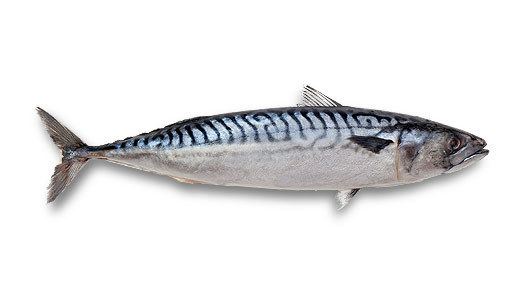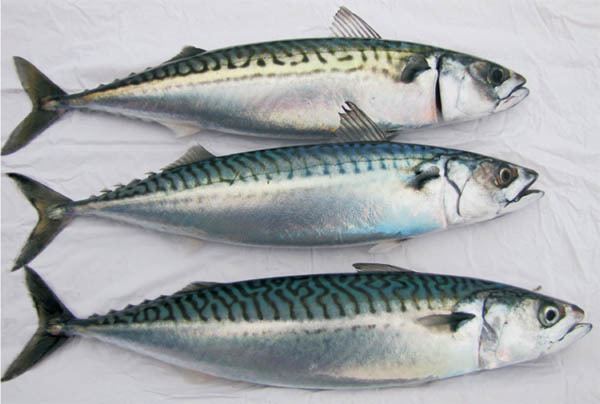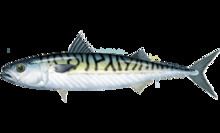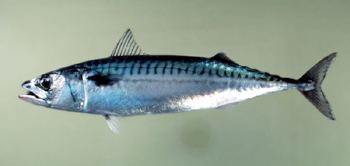Order Perciformes | ||
 | ||
Similar Atlantic salmon, True tunas, Sardine, Haddock, Fish as food | ||
The Atlantic mackerel (Scomber scombrus), also known as Boston mackerel, Norwegian mackerel, Scottish mackerel or just mackerel, is a pelagic schooling species of mackerel found in the Mediterranean Sea, the Black Sea, and both sides of the North Atlantic. It can reach sizes of up to 60 cm (24 in) and 3.4 kg (7.5 lb), but rarely grows above 50 cm (20 in). Its body is steel-blue dorsally and silvery-white ventrally, the top marked by wavy Black lines. Its dorsal fins are spaced widely apart. During the summer, which it spends closer to shore, it is extremely common in huge shoals near the ocean surface. When fall arrives, the mackerel begin to move out into deeper southern waters and will not be seen close to shore until spring. Atlantic mackerel reach sexual maturity around 2 years of age and can live to be 17. Reproduction is oviparous and occurs during the summer months, during which a female can produce several hundred thousand eggs.
Contents
- Sabiki rigging atlantic mackerel hd
- Taxonomy and phylogeny
- Description
- Distribution and habitat
- Biology and ecology
- Feeding
- Life history
- Fisheries
- As food
- Conservation
- References

The Atlantic mackerel is a significant food source and of high commercial and ecological importance. In 2014, over 1.4 million tonnes of Atlantic mackerel were brought in by fisheries worldwide. Even though it is highly sought after by fisheries, it is listed as Least Concern by the International Union for the Conservation of Nature (IUCN) and catches have remained sustainable.

Sabiki rigging atlantic mackerel hd
Taxonomy and phylogeny
The Atlantic mackerel was first described in 1758 by Swedish zoologist Carl Linnaeus in his 10th edition of Systema Naturae. Linnaeus gave it the scientific name Scomber scomber from the Greek word skombros meaning "tunny" or "mackerel." Because of its wide distribution, the Atlantic mackerel was independently described 6 more times by 5 different scientists between 1814 and 1863. Its specific name was later changed to scombrus by B. B. Collette and C. E. Nauen in 1983. It is differentiated from its congeners in a number of ways, the first being the absence of a swim bladder. Its palatine bone is also wider than other members of its genus and its otolith is oval-shaped where its congeners' are rectangular.
Description

The Atlantic mackerel has an elongate, fusiform body with a long, pointed snout. The eyes are large and covered by an adipose eyelid, while the teeth are small, sharp, and conical. Scales are also small, with the exceptions of those immediately posterior to the head and around the pectoral fins. These small scales give the Atlantic mackerel a velvet-like feel. The two dorsal fins are large and spaced far apart. The second dorsal fin is followed by 5 dorsal finlets, though it can have 4 or 6. The anal fin, which originates slightly behind the second dorsal fin, is similar to it in size and shape and is also succeeded 5 by finlets. The fish's body tapers to a slim caudal peduncle, the end of the fish to which the short but broad tail fin is attached. Its body is steel-blue dorsally with wavy black lines running perpendicular to the fish's length. The rest of its body is silvery-white to yellow and may have darker splotches. It can reach sizes of up to 60 cm (24 in) and has a common length of 30 cm (12 in). Its maximum published weight is 3.4 kg (7.5 lb).
Distribution and habitat
The Atlantic mackerel's native range in the western Atlantic extends from Labrador, Canada to Cape Lookout, North Carolina. In the eastern Atlantic, it can be found from Iceland to as far south as Mauritania. It is also found in the Mediterranean, Black, and Baltic Seas. Its latitudinal range is 70°N-25°N and its longitudinal range is 77°W-42°E. Its preferred water temperature is above 8 °C (46 °F), but they are common in waters as cold as 7 °C (45 °F) and have rarely been found in 4.5 °C (40.1 °F) conditions. Their depth range extends from the surface to as deep as 1,000 m (3,300 ft), but they are usually found above 200 m (660 ft).

Atlantic mackerel are migratory fish, spending the spring and summer closer to shore about 32–161 km (20–100 mi) out, with juveniles moving closer in to shore than adults. Occasionally, fish will even enter harbors, and those that do are usually juveniles. In the fall and winter they move farther out and farther south to the warmer waters on the edge of the continental shelf. They first come in to land in North America in April at the southern end of their range, but are found along the coast through their entire range by July. They start moving back out to sea again in September and are completely gone from the coast by December. Food availability increases greatly during the summer, and fish reach a peak for Fat tissue in August, a mere four months after their lowest point in April.
Biology and ecology

The Atlantic mackerel is an active, fast-moving fish that must keep in constant motion to bring in enough oxygen. It swims using short movements of the rear of its body and the caudal fin. Unlike other mackerels, however, they don't leap out of the water unless attempting to escape a predator. Atlantic mackerel form large schools near the ocean surface during all seasons but winter. Schools tend to be formed based on the size of the fish, which in turn impacts swimming ability. Larger fish have a greater ratio of muscle mass to surface area.
Feeding

When feeding on larger prey, schools tend to break down into shoals, and fish find food on their own. When consuming plankton, however, mackerels open their mouths as wide as possible, extend their operculums, and form a tightly-packed school that acts like a series of miniature tow nets. Spaced only about the diameter of a single fish's mouth apart, their formation greatly reduces the ability of plankton to evade capture, as a plankton darting out of the jaws of one fish is likely to end up in the jaws of another. Copepods make up the majority of the Atlantic mackerel's diet and of the copepods it eats, Calanus finmarchicus makes up the greatest portion.
Life history
Like other mackerels, reproduction in the Atlantic mackerel is oviparous. Spawning occurs day or night in the spring and summer months, primarily within 48 km (30 mi) of shore, though it can occur as far out as 130 km (81 mi). A single female can spawn as many as 450,000 eggs in a spawning season. Eggs mature in batches over the course of a week and are pelagic once released, remaining within 15–25 m (49–82 ft) of the surface. Time to hatching is dependent on the water temperature, and ranges from 2 days at 21 °C (70 °F) to 8.5 days at 10 °C (50 °F). Most eggs are spawned in waters 9–12 °C (48–54 °F) in temperaure, and as such the majority of eggs hatch in about a week. Eggs are anywhere from 1.0–1.3 mm (0.039–0.051 in) in size, trending towards smaller as the spawning season goes on. Larvae undergo three developmental stages: the yolk sac stage, the larval stage, and the post-larval stage. Larvae are 3 mm (0.12 in) when they hatch and feed on the yolk sac for about 5 days. During the larval stage, which lasts about a month, larvae grow to 10 mm (0.39 in) in length. They are largely incapable of swimming, instead floating with the current. During the post-larval stage, which occurs over the next 40 days and during which the fish reaches 50 mm (2.0 in) in length, it swims to the surface at night and down to deeper waters during the day. At the end of the post-larval stage, juveniles resemble an adult mackerel in all but size. Schooling behavior occurs around this time.
Sexual maturity is reached at around 2 years of age, though some fish may reproduce a season earlier or a season later. Though some fish are sexually mature at 25 cm (9.8 in) in length, even by 34 cm (13 in) only about half of females will be ready to reproduce. At 37 cm (15 in), 90% of fish are capable of reproduction. An atlantic mackerel can live for up to 17 years and attain a length of 60 cm (24 in) and a weight of 3.4 kg (7.5 lb).
Fisheries
A highly commercialized species, the Atlantic mackerel is of significant importance to many Atlantic fisheries. It is caught with purse seines, trawls, and gill and trammel nets, as well as with hook and line by recreational fishers. Catch data goes as far back as the 1950's, and for most years since, it has remained under 1 million tonnes. In 2014, however, more than 1.4 million tonnes of Atlantic mackerel were brought in worldwide, almost a 50% increase in catch. There are two known stocks of Atlantic mackerel in the northeast Atlantic: one in the North Sea and one around the British Isles. There two more distinct stocks in the western Atlantic: northern and southern stocks, each of which occupies different territories during the stages of their migration.
As food
Atlantic mackerel are sought after for food either cooked or as sashimi and consist mostly of red meat with a strong taste desirable to some consumers. The fish is extremely high in vitamin B12 as well as omega 3 (a class of fatty acids) and contains nearly twice as much of the latter per unit weight as salmon. Unlike the King and Spanish species, Northern Atlantic mackerel are very low in mercury, and can be eaten at least twice a week according to EPA guidelines. Mainly in Scandinavia and the United Kingdom, canned mackerel in tomato sauce, brine, or vegetable oil is sometimes eaten with salad or in sandwiches. Mackerel is an excellent source of phosphatidylserine, as it contains about 480 mg / 100 grams by weight.
Conservation
Despite its commercial status, the Atlantic mackerel was assessed to be of Least Concern by the IUCN in 2011. Its abundance and extensive range combined with a cyclical increase/decrease mean that it is not currently in danger of going extinct. The IUCN did recommend careful monitoring, however, especially as the impacts of climate change may impact population and distribution. In the northeastern Atlantic, several countries impose minimum landing sizes. In the EU this size is 18 cm (7.1 in), Ukraine 15 cm (5.9 in), Turkey 20 cm (7.9 in), and Romania 23 cm (9.1 in). As of 2011 there were no conservation measures in place in the Northwest Atlantic.
